A close friend of ours (a Cretan who's never left the country) told us that he recently went out to a Chinese restaurant in Hania. My family generally likes Chinese restaurant food (let's not mix up the marketed product with what the Chinese cook at home), and we've never been disappointed with a Chinese meal during our travels. What's more, Greek and Chinese cultures, while they seem very divergent in terms of the dishes and cooking techniques, actually share a lot of other parameters involved in the dinner setting: both cultures enjoy their meals in the company of family and friends, they both include all generations in a table setting, they like to see and taste a wide variety of dishes on the table, and all the dishes are shared. This is so unlike the Western tradition of ordering one plate per person, dining mainly with one's partner or a group of people in a similar predicament, and hardly ever in the company of children.
"So what did you like most?" I asked my friend. "Sweet and sour pork? Fried rice? Lemon chicken?"
"I didn't like anything," he said. Our friend told us that he couldn't remember the names of the dishes that came to the table, but he'd gone there with his παρέα mainly for the experience and that they'd ordered a lot of dishes, but most of the food remained untouched. On the one hand, I was annoyed to hear about his elitist attitude towards other people's food, especially towards one of the most dispersed cuisines in the world. At the same time, however, I could understand how he felt; most of the locals here know 'their' food so well, that they can't appreciate other people's food.They prefer not just Greek cuisine, but Cretan cuisine.
We all have a concept of what constitutes good food; we all know what we really like to eat. Some of us prefer old favorites that we've grown up with, while others state as their favorite choice in food a meal that they may have tried away from the home environment. But many of us go a step beyond that: some people seek out the food of their culture, even if it isn't available where they are. This is especially noticeable in our days among minority communities. Immigrants generally have a tendency to seek out their food wherever they go.
In Hania, we can generally find a wide range of different foods from different cultures. A variety of foreign foodstuff is sold at the supermarkets of the town. These are often displayed in a section of the shelves specifically labelled 'international tastes'. They usually consist of packaged food items, eg na'an bread, Chinese noodles, bottled curry paste, etc, and are available in small quantities. Some of those foreign items have gained ground and are sold in larger quantities, eg soy sauce (which is now available by the litre). In its own way, foreign food has also become big business: LIDL (Greece) often advertises an 'ethnic specials' week, where it brings in a range of processed food from different cultures. These items are only available for one week, giving rise to panic shopping habits when a particular cuisine is being advertised, eg a range of 'English' frozen, canned and bottled foodstuff - the British tourist residents of Hania have usually bought all the stock by midday! At the same time, the locals may be buying some of these products too, either to try them out of curiosity or because they want to enjoy them as they did during their travels - in my opinion, it's only a few who do will do this. Such imported items are also - unsurprisingly - the most expensive items sold at supermarkets.
 Hania definitely lacks a foreign restaurant culture, as is commonly seen in the West. A very small number of Chinese restaurants operate in Hania, but only during the tourist season; once tourists leave the island when the summer season is over, the Chinese restaurants close down, with only two exceptions which remain open the whole year round, serving the odd young παρέα. The cost of a Chinese meal works out to much more than the average cost of a meal out at a local taverna, where the food is less processed, more seasonal and almost always local. What's more, not all the Chinese restaurants in Hania are necessarily owned by Chinese...
Hania definitely lacks a foreign restaurant culture, as is commonly seen in the West. A very small number of Chinese restaurants operate in Hania, but only during the tourist season; once tourists leave the island when the summer season is over, the Chinese restaurants close down, with only two exceptions which remain open the whole year round, serving the odd young παρέα. The cost of a Chinese meal works out to much more than the average cost of a meal out at a local taverna, where the food is less processed, more seasonal and almost always local. What's more, not all the Chinese restaurants in Hania are necessarily owned by Chinese...
There are no South Asian restaurants in the town, and the one Bulgarian restaurant that I had noticed operating two years ago has now closed. Many restaurants serve a range of well-known international dishes, but few specialise in only one cuisine, although this does exist, as with the well-established Bigazza serving Turkish cuisine in the village of Galatas, and a couple of others by the old Venetian harbour, serving Italian cuisine (not to be confused with the image of the popular pizza-pasta menu in the various pizzerias in the town). They are popular among the locals for obvious reasons: both cuisines share similarities with the local one, further proof that Greece is at the crossroads of the East and West. (Right: Looking onto the road in Wong Kei, London, in the middle of London's Chinatown)
Despite the lack of international cuisine, Hania can be said to be a truly multi-cultural town. Throughout its contemporary history, there has always been a foreign element. The old minaret adjacent to St Nikolaos church is a perfect reminder of the meeting of East and West. Despite the negative connotations surrounding the period when the island was under Turkish rule, Ottoman remnants abound in the town, and so do the Venetian reminders. The most well-known landmarks are the former mosque and the Venetian lighthouse, both located by the harbour.
The lighthouse was restored at one point in the 1800s by the Egyptians, who also spent some time here). Despite the fact that during the population exchange after the 1922 Smyrna crisis, all the Cretan Muslims (Turks) were required to leave the island, many Turkish-speaking Greeks came to take their place. The Jews were rounded up during WW2, to be replaced by the Nazis. Economic migrants have been coming to Hania since Greece entered the EU, and now, if you walk down any street in the town at any time of the day, you can be guaranteed of hearing a wide variety of foreign languages. Skirmishes among racial groups do break out - but they are usually confined within the groups themselves, rather than as racist attacks of the locals against the foreigners. Although Hania has recently had a rise in petty crime (as has happened everywhere in Greece, especially since the economic crisis took hold), it has not resulted in Hania becoming a less safe town than what it was.
The population of the greater area of Hania can be estimated at about 150,000-160,000, the biggest throughout its history. The Balkan countries of Albania, Bulgaria and Romania are heavily represented in Hania, and there is also a significant number of Pontiacs (Greeks from Russia) who are all predominantly Christian. The large Muslim population in Hania is mainly made up of Albanians and Arabs from North Africa, the Middle East and Pakistan. There are also many other ethnic groups living in Hania, but their numbers are small. Hania is also home to the largest proportion of ex-pat EU-15 citizens in the country: of the total number of British ex-pats permanently residing in Greece, nearly two thirds live here, along with a number of German ex-pats (who generally prefer Eastern Crete). Finally, there is a visibly significant Chinese community, characterised as such by their appearance. The ones I've talked to say they are from Shanghai; judging by what they name their shops, they probably they are. A kind of chain migration could be in evidence.
We have plenty of foreigners but we don't have plenty of eateries serving their food. One hypothesis about the lack of international cuisine in Hania could be that foreigners are happy to eat Greek food, but that's highly unlikely from my own experience of immigrant communities abroad. Having said that, it should be pointed out that the Balkan, Pontiac and Arab ex-pats share a similar cuisine to our own. At the same time, these migrants are rarely seen eating in the local tavernas. Apart from the 'foreign food' aspect, this is also most likely due to economic reasons. For religious reasons, Muslim migrants will probably not be eating out, either: the most popular fast food in Greece, souvlaki, is made from pork (although chicken is also offered these days at all souvlatzidika as an alternative to pork), which is also the most popular meat, judging from the quantities of meat displayed for sale on Fridays and Saturdays (when most people do their shopping) at the supermarket meat counters (where most people buy their food from these days).
Greek slaughter practices do not follow the halal code, so devout Muslims must be buying their meat elsewhere, maybe from one of the few stores operated by immigrants which have sprouted up around the town selling home-food products for those 'ex-pats' (Greeks rarely buy from these places). The Northern European 'tourist residents' are probably well looked after in culinary terms by the multi-national supermarket chains (LIDL, Carrefour and AB Vassilopoulos) which all stock imported produce that most Northern Europeans will be familiar with, such as peanut butter, Betty Crocker pancake mixes, Dutch-grown (or Dutch-distributed) fruits and vegetables, Perrier water, bottled raspberries, imported cranberries, foreign cheeses like brie, camembert and gorgonzola, frozen fish and chips and roast beef dinners (seriously!), among many others. The reputation of British cuisine may be blighted by the gastronomes, but it seems that the British do seek their own food too, as they are the ones who are most likely to use mail order services to procure food items, or to pick up supplies from 'home' when they visit, which is likely to be on a more frequent basis than other minority cultures represented in the area (this happens for economic reasons: Northern Europeans are often retired citizens receiving a pension, while all the others are economic migrants working in Greece, who are more likely to use slower transport methods rather than flights to return home for a visit).
That leaves the Chinese minority, whose cuisine is radically different from the local one. Chinese restaurants often abound in areas where Chinese immigrants congregate. Most Chinese migrants start off their working life in a foreign country in the kitchen of a Chinese restaurant. Why isn't this happening in Hania, too? Our friend's opinion (see top of post) is not a unique one; locals here are not very adventurous food-wise. International cuisine of this type is highly unlikely to gain ground in Hania, especially during an economic crisis, despite the high number of locals travelling these days. They are likely to have encountered Chinese restaurants in their travels, but it's highly unlikely that they would have been impressed enough by it to desire it when they returned home. I believe that international cuisine in Hania will never win over local food. Even if it did gain some ground, it would probably be too expensive, quite the opposite situation in the West, where Chinese restaurants are often the cheapest places to eat. International cuisine is still seen as 'foreign food' here, 'not for us'. Some of us simply do not take so easily to the idea of eating other people's food. Greek people can be said to be a bit like this. But so can the Chinese.
So what are the Chinese doing here in Hania? And what are they eating?
"So what did you like most?" I asked my friend. "Sweet and sour pork? Fried rice? Lemon chicken?"
Sticky ribs (left) and lemon chicken (right): Wong Kei, London. Just like Greek restaurant food, Chinese restaurant food can be rather predictable. The dishes I ate in Chinese restaurants in London didn't taste much different from the meals that go by the same name in the Chinese restaurants I remember eating in my hometown, Wellington, New Zealand; even the colour and texture of the sauces looked familiar.
"I didn't like anything," he said. Our friend told us that he couldn't remember the names of the dishes that came to the table, but he'd gone there with his παρέα mainly for the experience and that they'd ordered a lot of dishes, but most of the food remained untouched. On the one hand, I was annoyed to hear about his elitist attitude towards other people's food, especially towards one of the most dispersed cuisines in the world. At the same time, however, I could understand how he felt; most of the locals here know 'their' food so well, that they can't appreciate other people's food.They prefer not just Greek cuisine, but Cretan cuisine.
Not only is Chinese food radically different from Greek food, but even the way the table is laid for the diner bears no resemblance between the cuisines: the cutlery (chopsticks instead of knives and forks), the first beverage (tea, not water), the kind of plates (small bowls, as opposed to wide platters) and the condiments (soy and chili sauce as opposed to olive oil and vinegar) all create a shock to the veritable Cretan's system when they first encounter such a setting!
We all have a concept of what constitutes good food; we all know what we really like to eat. Some of us prefer old favorites that we've grown up with, while others state as their favorite choice in food a meal that they may have tried away from the home environment. But many of us go a step beyond that: some people seek out the food of their culture, even if it isn't available where they are. This is especially noticeable in our days among minority communities. Immigrants generally have a tendency to seek out their food wherever they go.
In the last few years, the range of foreign products available in Hania has grown tremendously, catering mainly for the Northern European 'tourist residents': they came here on holiday, they liked the place, they bought their own property and retired here. They are never referred to as 'migrants', neither in the English (ex-pats) nor the Greek language (ξένοι vs μετανάστες).
In Hania, we can generally find a wide range of different foods from different cultures. A variety of foreign foodstuff is sold at the supermarkets of the town. These are often displayed in a section of the shelves specifically labelled 'international tastes'. They usually consist of packaged food items, eg na'an bread, Chinese noodles, bottled curry paste, etc, and are available in small quantities. Some of those foreign items have gained ground and are sold in larger quantities, eg soy sauce (which is now available by the litre). In its own way, foreign food has also become big business: LIDL (Greece) often advertises an 'ethnic specials' week, where it brings in a range of processed food from different cultures. These items are only available for one week, giving rise to panic shopping habits when a particular cuisine is being advertised, eg a range of 'English' frozen, canned and bottled foodstuff - the British tourist residents of Hania have usually bought all the stock by midday! At the same time, the locals may be buying some of these products too, either to try them out of curiosity or because they want to enjoy them as they did during their travels - in my opinion, it's only a few who do will do this. Such imported items are also - unsurprisingly - the most expensive items sold at supermarkets.
 Hania definitely lacks a foreign restaurant culture, as is commonly seen in the West. A very small number of Chinese restaurants operate in Hania, but only during the tourist season; once tourists leave the island when the summer season is over, the Chinese restaurants close down, with only two exceptions which remain open the whole year round, serving the odd young παρέα. The cost of a Chinese meal works out to much more than the average cost of a meal out at a local taverna, where the food is less processed, more seasonal and almost always local. What's more, not all the Chinese restaurants in Hania are necessarily owned by Chinese...
Hania definitely lacks a foreign restaurant culture, as is commonly seen in the West. A very small number of Chinese restaurants operate in Hania, but only during the tourist season; once tourists leave the island when the summer season is over, the Chinese restaurants close down, with only two exceptions which remain open the whole year round, serving the odd young παρέα. The cost of a Chinese meal works out to much more than the average cost of a meal out at a local taverna, where the food is less processed, more seasonal and almost always local. What's more, not all the Chinese restaurants in Hania are necessarily owned by Chinese...There are no South Asian restaurants in the town, and the one Bulgarian restaurant that I had noticed operating two years ago has now closed. Many restaurants serve a range of well-known international dishes, but few specialise in only one cuisine, although this does exist, as with the well-established Bigazza serving Turkish cuisine in the village of Galatas, and a couple of others by the old Venetian harbour, serving Italian cuisine (not to be confused with the image of the popular pizza-pasta menu in the various pizzerias in the town). They are popular among the locals for obvious reasons: both cuisines share similarities with the local one, further proof that Greece is at the crossroads of the East and West. (Right: Looking onto the road in Wong Kei, London, in the middle of London's Chinatown)
When we travel outside Greece, it's always a bit of a trial finding a place to eat that makes everyone happy. A Chinese meal bears no resemblance to a Greek meal, which creates problems particularly for my son, who could be described as a fussy eater. When the egg pancakes and crispy duck arrived, together with their special sauce and sliced vege condiments, I had to find a way to convince him that this food is similar to what we eat at home: I told him that Chinese restaurants serve roll-your-own souvlaki.
Despite the lack of international cuisine, Hania can be said to be a truly multi-cultural town. Throughout its contemporary history, there has always been a foreign element. The old minaret adjacent to St Nikolaos church is a perfect reminder of the meeting of East and West. Despite the negative connotations surrounding the period when the island was under Turkish rule, Ottoman remnants abound in the town, and so do the Venetian reminders. The most well-known landmarks are the former mosque and the Venetian lighthouse, both located by the harbour.
The lighthouse was restored at one point in the 1800s by the Egyptians, who also spent some time here). Despite the fact that during the population exchange after the 1922 Smyrna crisis, all the Cretan Muslims (Turks) were required to leave the island, many Turkish-speaking Greeks came to take their place. The Jews were rounded up during WW2, to be replaced by the Nazis. Economic migrants have been coming to Hania since Greece entered the EU, and now, if you walk down any street in the town at any time of the day, you can be guaranteed of hearing a wide variety of foreign languages. Skirmishes among racial groups do break out - but they are usually confined within the groups themselves, rather than as racist attacks of the locals against the foreigners. Although Hania has recently had a rise in petty crime (as has happened everywhere in Greece, especially since the economic crisis took hold), it has not resulted in Hania becoming a less safe town than what it was.
A Turkish minaret, built onto one side of St Nicholas' church in Splantzia, whose bell tower can be seen.
Left: the local hangout of the immigrants in our town is the taxi rank by Plateia 1866 (the Chinese are never ever seen to congregate in this fashion). Right: migrant's home. Hania relies on immigrant labor in most sectors of the economy. Agriculture, tourism and construction would never have advanced without immigrants' input.
Pork is always over-represented at the supermarket, except during the Easter period (when lamb is more popular).
Greek slaughter practices do not follow the halal code, so devout Muslims must be buying their meat elsewhere, maybe from one of the few stores operated by immigrants which have sprouted up around the town selling home-food products for those 'ex-pats' (Greeks rarely buy from these places). The Northern European 'tourist residents' are probably well looked after in culinary terms by the multi-national supermarket chains (LIDL, Carrefour and AB Vassilopoulos) which all stock imported produce that most Northern Europeans will be familiar with, such as peanut butter, Betty Crocker pancake mixes, Dutch-grown (or Dutch-distributed) fruits and vegetables, Perrier water, bottled raspberries, imported cranberries, foreign cheeses like brie, camembert and gorgonzola, frozen fish and chips and roast beef dinners (seriously!), among many others. The reputation of British cuisine may be blighted by the gastronomes, but it seems that the British do seek their own food too, as they are the ones who are most likely to use mail order services to procure food items, or to pick up supplies from 'home' when they visit, which is likely to be on a more frequent basis than other minority cultures represented in the area (this happens for economic reasons: Northern Europeans are often retired citizens receiving a pension, while all the others are economic migrants working in Greece, who are more likely to use slower transport methods rather than flights to return home for a visit).
Left: I've spoken to this woman in the past; I was surprised to see her one year later, wearing the same clothes, doing the same job, and still living in Hania. The woman peddling goods told me she was from Shanghai. Right: The red lanterns hanging above the shop immediately denote what one will find here. This κινέζικο is very small compared to other κινέζικα, because it is located in the centre of town, where business premises are smaller and rental space is at a premium.
That leaves the Chinese minority, whose cuisine is radically different from the local one. Chinese restaurants often abound in areas where Chinese immigrants congregate. Most Chinese migrants start off their working life in a foreign country in the kitchen of a Chinese restaurant. Why isn't this happening in Hania, too? Our friend's opinion (see top of post) is not a unique one; locals here are not very adventurous food-wise. International cuisine of this type is highly unlikely to gain ground in Hania, especially during an economic crisis, despite the high number of locals travelling these days. They are likely to have encountered Chinese restaurants in their travels, but it's highly unlikely that they would have been impressed enough by it to desire it when they returned home. I believe that international cuisine in Hania will never win over local food. Even if it did gain some ground, it would probably be too expensive, quite the opposite situation in the West, where Chinese restaurants are often the cheapest places to eat. International cuisine is still seen as 'foreign food' here, 'not for us'. Some of us simply do not take so easily to the idea of eating other people's food. Greek people can be said to be a bit like this. But so can the Chinese.
So what are the Chinese doing here in Hania? And what are they eating?
*** *** ***
©All Rights Reserved/Organically cooked. No part of this blog may be reproduced and/or copied by any means without prior consent from Maria Verivaki.
It's difficult to say whether the Chinese immigrants actually form a community, as they seem to operate on an individual basis around the town. But everyone knows where to find the Chinese in Hania. Distinctive red lanterns above a shop window appear well before the business is even ready to start operating. The Chinese own clothes shops, which all sell cheap polyester-mix clothes. Chinese clothes shops (collectively referred to all over Greece as 'τα κινέζικα') never have the appearance of a boutique. The premises they occupy are hardly ever small; almost all remind me of a miniature version of Primark in London. There are many Chinese clothes shops all over the town (as there are in most Greek towns), especially outside the centre of the town, where more spacious premises are available. Some seem to be busy, others not so. This is why the Chinese immigrants in Crete don't seem to work as a community. Chinese clothes shops open up near each other, as if they are in competition with one another.
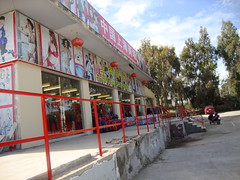

Gaudy, cheap and nasty - but people are easily enticed to enter these large clothes outlets: men, women and children are all catered for with a selection as wide (but not as expensive as) Marks and Spencers. The κινέζικα are all decorated by the owners themselves - their posters come straight from China by the looks of things; wherever there are red lanterns hanging over the door, there are Chinese.


Gaudy, cheap and nasty - but people are easily enticed to enter these large clothes outlets: men, women and children are all catered for with a selection as wide (but not as expensive as) Marks and Spencers. The κινέζικα are all decorated by the owners themselves - their posters come straight from China by the looks of things; wherever there are red lanterns hanging over the door, there are Chinese.
When they first started sprouting, Chinese clothes shops were very popular, because they sold very cheap clothes; no one wants to miss out on a bargain. People's attitudes have changed towards them over time, mainly as a response to the 'Made in China' quality. Most of the time, the clothes smell of polyester fibre, even though the labels sewn on them state '100% cotton' (they also state that they are 'Made in Italy', while the supermarkets ostentatiously sell the 'Made in China' label). The clothes always seem to make you sweat; that's when the smell really comes out. This wouldn't be a big problem in colder climates; in the Mediterranean climate of Crete, this kind of clothing is wholly inappropriate. The wide variety of colours that each clothing item is sold in makes up for the shapeless styles. There seems to be a wide size range: anything from XS to XXXL - but even XXXL is often too small for me, even though I can snugly fit into a size 14 pair of jeans at Marks and Spencers. Our summer tourists like shopping for clothes at these 'emporiums, probably because they're cheap. Put it this way: you get what you pay for.
To the average visitor, the gaudy Chinese shops are often an incongruous sight in the Cretan landscape, but most locals will have gotten used to them by now. They don't seem to care if they are there or not, even if the Greek spelling on the signs of their shop windows is correct or not. They are literally everywhere. They don't impress me now; I'm used to their garish displays. But the κινέζικο that I pass every day to and from work bids me to enter for a reason other than the goods it sells. It's found in the dingy suburb of Koumbes, on the Western outskirts of the town, at the messy junction linking the road leading to the ferry port of Souda Bay with the town centre.
Koumbes is home to the police headquarters and it shelters a high school complex which still operates in the archaic Greek fashion of having two separate school rolls sharing one school building, with a morning shift (8.00am-1.30pm) of students and an afternoon (2.00pm-7.30pm) shift (as one group leaves, another arrives, and the groups alternate weekly as to who attends each shift). This system has been in use for a long time in Greece, the excuse for it being that there are not enough school buildings to accommodate all the students of an area, hence the school premises are used 'twice' in one day. Koumbes is a densely populated working-class suburb, with rows of functional-looking low apartment blocks and some single- and double-story houses, some of the first to be built in the area, standing awkwardly side-by-side. The landmark feature of Koumbes is the wide busy junction known as the φανάρια του Κουμπέ ("the Koumbe traffic lights"). The roads suddenly become narrower here, just when you least expect this, and the footpaths seem to disappear, even though the traffic is roaring left, right and centre.
The premises of the Chinese shop once housed an established καφενείο, which eventually closed down after the owner retired. Since then, it became another kafeneio, a billiards club and another taverna (twice), all of which went out of business in less than a few months. It was then snapped up by a Κινέζο, who turned into a κινέζικο. The premises stand on the corner of the road, lined with decorative brick-built raised flower beds. Every day as I pass by to and from work, I marvel at the dark green foliage sprouting from the flower beds which looks very uniform and weed-free. I couldn't recognise the plants in it, either - I had never seen these plants growing anywhere before. They slowly started to take shape: bok choy and kale (I think) are now seen for the first time in Hania!

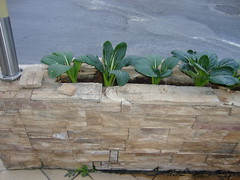
Chinese vegetables in the flower beds: kai choi (left0 and bok choi (right). I wasn't the only one observing them; a couple of Greek women, customers of the κινέζικο, came out of the shop and did the same thing, touching the leaves, bending down to smell them, and asking each other what kind of horta these could be. The owner of the shop was very reticent about sharing information - "δεν έχετε εδώ", "όχι ελληνικά", "πάρουμε από Κίνα", plus a few hand movements showing me how she cooked them (I think she was mimicking the movements made above a wok). Pictured below is the busy junction where the leafy vegetables were growing.
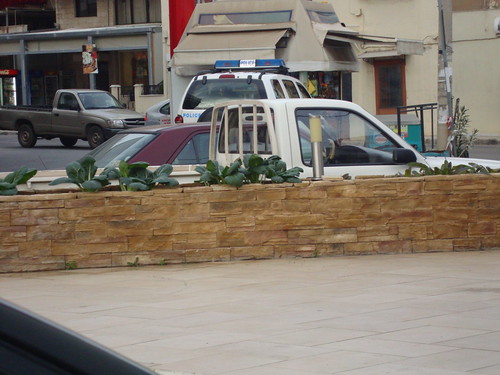
Now I know where the Chinese get their food in Crete: They must be growing some of it themselves wherever possible. This reminds me of how my parents and other Greek immigrants used to sneak back seed packets of vlita, radiki and local varieties of pepper in their suitcases after a trip to the homeland. Just like them, the Κινέζο misses his home food; the Cretan climate, while not the most appropriate for Chinese clothing, is perfect for growing Chinese vegetables. I commend his idea of growing vegetables in the flower beds; it's more sustainable to grow something edible than something pretty just to look at. Flowers are very attractive, but they often get neglected in business premises. But whether you have a business or not, you have to eat, and if you want to eat your food, you've got to make the effort!
Special thanks to Stella, who is celebrating her nameday today, for helping me with the Chinese names of the vegetables.
The landmark junction in Koumbes includes a former mosque, which has been used for many years now as a ψησταριά - it sells some of the best rotisserie chicken in Hania - and a hairdresser's. Note the narrow roads lacking footpaths straight ahead of the traffic lights. The κινέζικο growing the Chinese vegetables in directly to the right of the blue car.
Koumbes is home to the police headquarters and it shelters a high school complex which still operates in the archaic Greek fashion of having two separate school rolls sharing one school building, with a morning shift (8.00am-1.30pm) of students and an afternoon (2.00pm-7.30pm) shift (as one group leaves, another arrives, and the groups alternate weekly as to who attends each shift). This system has been in use for a long time in Greece, the excuse for it being that there are not enough school buildings to accommodate all the students of an area, hence the school premises are used 'twice' in one day. Koumbes is a densely populated working-class suburb, with rows of functional-looking low apartment blocks and some single- and double-story houses, some of the first to be built in the area, standing awkwardly side-by-side. The landmark feature of Koumbes is the wide busy junction known as the φανάρια του Κουμπέ ("the Koumbe traffic lights"). The roads suddenly become narrower here, just when you least expect this, and the footpaths seem to disappear, even though the traffic is roaring left, right and centre.
Schools in Greece are named after the region they are located in; if there is more than one school in the region, they are then assigned numbers. The 3rd and 4th junior high schools of Hania are located in the same premises.
The premises of the Chinese shop once housed an established καφενείο, which eventually closed down after the owner retired. Since then, it became another kafeneio, a billiards club and another taverna (twice), all of which went out of business in less than a few months. It was then snapped up by a Κινέζο, who turned into a κινέζικο. The premises stand on the corner of the road, lined with decorative brick-built raised flower beds. Every day as I pass by to and from work, I marvel at the dark green foliage sprouting from the flower beds which looks very uniform and weed-free. I couldn't recognise the plants in it, either - I had never seen these plants growing anywhere before. They slowly started to take shape: bok choy and kale (I think) are now seen for the first time in Hania!


Chinese vegetables in the flower beds: kai choi (left0 and bok choi (right). I wasn't the only one observing them; a couple of Greek women, customers of the κινέζικο, came out of the shop and did the same thing, touching the leaves, bending down to smell them, and asking each other what kind of horta these could be. The owner of the shop was very reticent about sharing information - "δεν έχετε εδώ", "όχι ελληνικά", "πάρουμε από Κίνα", plus a few hand movements showing me how she cooked them (I think she was mimicking the movements made above a wok). Pictured below is the busy junction where the leafy vegetables were growing.

Now I know where the Chinese get their food in Crete: They must be growing some of it themselves wherever possible. This reminds me of how my parents and other Greek immigrants used to sneak back seed packets of vlita, radiki and local varieties of pepper in their suitcases after a trip to the homeland. Just like them, the Κινέζο misses his home food; the Cretan climate, while not the most appropriate for Chinese clothing, is perfect for growing Chinese vegetables. I commend his idea of growing vegetables in the flower beds; it's more sustainable to grow something edible than something pretty just to look at. Flowers are very attractive, but they often get neglected in business premises. But whether you have a business or not, you have to eat, and if you want to eat your food, you've got to make the effort!
Special thanks to Stella, who is celebrating her nameday today, for helping me with the Chinese names of the vegetables.
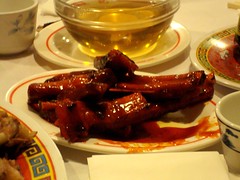
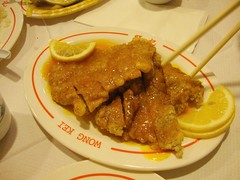
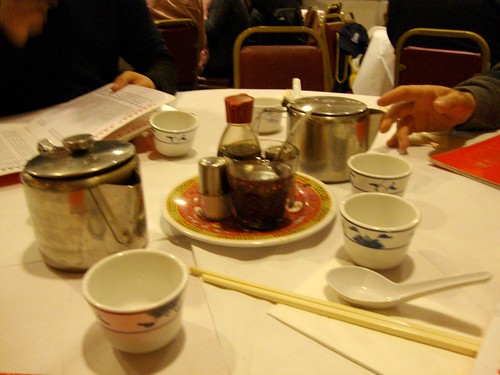

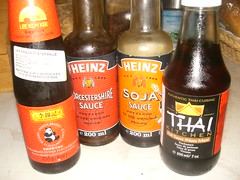
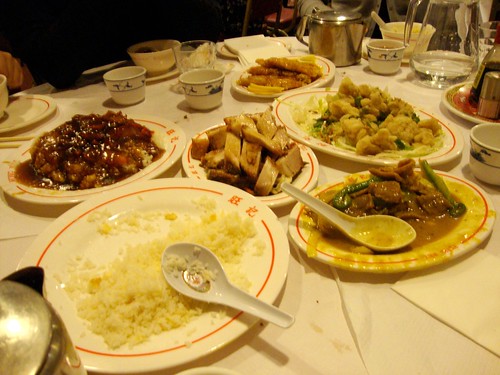

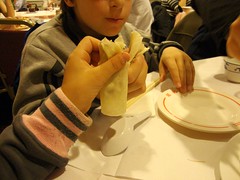


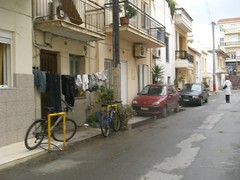
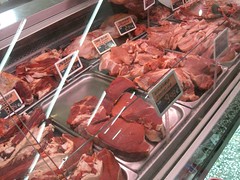
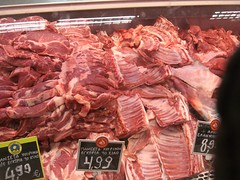

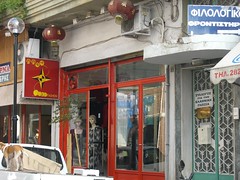

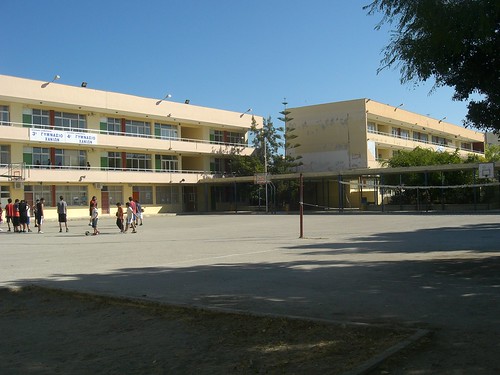
Very interesting about the Chinese in Crete! I grew up in a Chinese community in Cupertino, California (home to Apple computer). All our fathers were engineers. I was the one Greek with the Chinese and grew up eating Chinese food. I went to a Chinese resturant in Skaithos, where my Aunt and Uncle live in the summer. A Greek married a Chinese and they started a business there. Very interesting. I'd also like to add that in Los Angeles, we had a Chinese member of our all Greek parea. We called him KINEZO and he called himself that. He had all the reek manerisms and sayings. We have pooled money to pay for his license place "KINEZO" ;)
ReplyDeleteChinese food is incredibly diverse and regional but because 'white people' don't know what to order, there's no reason for an owner to waste his time importing ingredients and putting it on a menu. Especially for Greeks who are prejudice against food outside their own.
ReplyDeleteThis post makes your chauvinism quite transparent and shows that you are not international or knowledgeable about foods of other cultures. That happens often to housewives who think traveling once in awhile makes them worldly. Hardly.
(i am repeating this information, just in case the person who wrote this deletes their comment)
ReplyDeletean anonymous reader (from Athens) wrote:
"Chinese food is incredibly diverse and regional but because 'white people' don't know what to order, there's no reason for an owner to waste his time importing ingredients and putting it on a menu. Especially for Greeks who are prejudice against food outside their own.
This post makes your chauvinism quite transparent and shows that you are not international or knowledgeable about foods of other cultures. That happens often to housewives who think traveling once in awhile makes them worldly. Hardly."
either this person hasnt read my post properly or they hate me.
I think that there are a lot of cultures - those 'high contact cultures' that are similar to what you say of the Chinese and Greeks - communal dishes to be shared, all generations sitting at one table, an emphasis on friends and family - most of the cultures of the world are actually, the Western ones are the only ones I can think of that aren't.
ReplyDeleteI can't imagine not liking Chinese restaurant food, unless maybe the restaurant was not a good one? Or they ordered the wrong dishes? And I can't imagine not eating cuisine that originates in a variety of countries and places.
I'm glad you covered this Maria...it's all very interesting to read how cuisines are viewed in different countries and how much they can vary. It's only natural I suppose. The food you describe here (lemon chicken etc..) was really popular here in the 70's and still is to some degree...now it's all about Thai food!
ReplyDeletei think that in my friend's case, since he was never travelled out of the country, the chinese meal was too much of a culture shock to him; he needed to be educated in a way to accept someone else's cuisine as food, which is the reason why i think he couldn't enjoy the meal - personally i couldnt imagine someone not enjoying a chinese meal, either, given so much choice and tasty flavours in such a meal
ReplyDeleteΗ φωτογραφία που απεικονίζει τον φάρο ανήκει σ'εμένα. Έχει αφαιρεθεί το υδατογράφημα και εχει δημοσιευτεί χωρίς την συγκατάθεσή μου. Παρακαλώ διαγράψτε αυτή τη φωτογραφία από την σελίδα σας, διαφορετικά θα κινηθώ νομικά εναντίον σας σύμφωνα με τον νόμο 2121/93 περί πνευματικής ιδιοκτησίας.
ReplyDelete